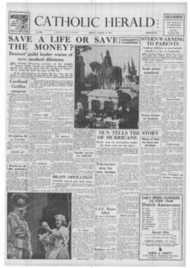Page 4, 31st August 1951
Page 4

Report an error
Noticed an error on this page?If you've noticed an error in this article please click here to report it.
Tags
Share
Related articles
(3) Don't Be 'cocky !
Are We Half-catholics?
Rally At Poplar
East End Catholics Discuss London Plan With Priest,...
The Scandal Over Fergie's Misconduct Points To A Mistake...
111"ST THE FAMILY THAT MATTERS
By Bernard Sullivan
CATHOLICS have always based their plans for a stable society on a good family life and have been often blamed for under-estimating the influence of a had environment.
On public platforms many reformers have called attention to the evils of slunis where a full life was made impossible.
We have seen earlier in this century how demoralising low wages can be, although there are many of the older generation who would claim that conditions were better in the good old days.
Today we see new homes springing up in all parts of the country, our children arc taught in bright modern schools, and full employmeut has removed the haunting spectre of poverty.
It is therefore interesting to note the interest the Government and local authorities arc now paying to the need for attention to family environment. Two committees have presented reports that have not received the attention in Catholic circles they deserved.
The Denning Committee reported on the procedure in matrimonial courses, and recommended the setting up of marriage welfare organisations sponsored by the Government with financial assistance, but leaving the bodies free from State interference.
Amongst the Associations that are now functioning is the Catholic Marriage Advisory Council.
A second committee, known as the Harris Committee, made recommendations about the type of organisation needed to take up marriage guidance, with a standard of training so necessary to inspire the people who come for advice and help.
Marriage advice
OUTSIDE the Catholic Church divorce has been considered to be the only remedy for a had marriage, and incompatible partners have looked forward to dissolution rather than reclamation of marriage.
Christian marriage is a sacrament, and the registrar merely gives legal form to the contracts. The civil marriage has developed with the decrease in church attendance, and a marriage founded on such flimsy grounds is less likely to bring forward a stable family than a religious ceremony, but these are unions that have failed because of lack of encouragement.
The Catholic Marriage Advisory Council has been functioning for nearly five years and in addition to ccoperating with the clergy to prevent a marriage becoming a failure, they tackle the problem before marriage takes place.
The betrothal was once a beautiful ceremony emphasising the approach to the sacrament. It might be considered that an announcement of the engagement should be as publicly made in church as the reading of the banns of marriage. There could
even be a religious ceremony to lend dignity to the pledge of betristhal.
These are points for the council to consider.
Every parish should know that pre-marital advice is available, and where complications arise after marriage, machinery is provided for helping the couple mei their difficulties.
Not so serious
ONE of the signs that marriage is not necessarily foolproof is shown in the reports frequently made on juvenile delinquency.
A committee is reporting on this subject, but there is so much ill-informed criticism that there is a danger of a wrong emphasis being obtained.
Those persons who are convinced that drink is the cause of poverty, that poverty is the cause of crime, that slums are dens of vice, arc ready to believe that juvenile delinquency is a crime bred of material conditions.
The well-meaning lecturers who seek to paint the picture in gloomy colours ever over-emphasise the problem.
Various local authorities have compiled analysis of the conditions under which the delinquents live, but few of the writers appear to have seen the reports and approach the problem from an emotional angle.
The figures from different counties generally agree and the extensive inquiry of the London County Council in their area can be said to be representative of the country. In the first place the problem is not as serious as is represented.
The figures
OF over half a million school children, there are less than five thousand who come before a magistrate for minor offences, generally for sonic form of stealing.
About 12 per cent. of these offenders come from Catholic schools, which is the proportion of the school population, while nine per cent. comes from the Church schools.
The Jews seem to have no delinquents attending their schools.
More boys are offenders than girls but the girls increase with age.
More than 50 per cent. of the scholars attend secondary modern schools. Secondary, Grammar and technical schools have the cleanest records.
The delinquents have not a record for truancy. The crimes are petty. About 25 per cent. of the boys steal from shops and stalls and 20 per cent. of the middle ages break into premises.
Twice the number of girls than boys steal from home. The boys show more interest in cars and cycles.
Of the sentences, 37 per cent. of the boys and 45 per cent. of the girls are placed on probation.
Only nine per cent. of the boys and 11 per cent. of the girls go to Approved Schools. Over 40 per cent. of both sexes have their cases dismissed.
About 70 per cent. of the boys and over 80 per cent. of the girls are first offenders. About 18 per cent. boys and 10 per cent. girls repeat their offences.
Catholics who are interested in the family can get little consolation from an analysis of the parents of these youthful criminals.
Eighty per cent. of the children live in homes that are not overcrowded, living not more than two persons per room. Over 76 per cent. boys and 68 per cent. girls arc living with their legal parents.
Nearly 68 per cent. of the children's fathers work near their homes.
Less than four per cent. of the father's were unemployed. Sixty per cent. of the mothers have no other occupation, only 17 per cent. work full time and 20 per cent. part-time.
Fifty-six per cent. of the children come from families of four to six members, while delinquency is least in very small or very big families.
Eighty-six per cent. of the boys come from average healthy parents and 84 per cent. were of good or average mentality.
Strong families
THESE figures will never be quoted in the irresponsible utterances of responsible people who make the sweeping statement of the nsaterial conditions that are responsible for the crimes.
Even the Government report is misleading as this paragraph shows.
It recognises a need for scientific inquiry into causes of de
linquency. It also suggests that the deep-seated and main longterm causes arise from the unsatisfactory home conditions (bad and over crowded housing, family conflicts, etc.), lack of affection and parental interest, failure to recognise and treat early enough children who are of sub-normal intelligence or who develop unstable, anti-social characters, the widespread influence of changing moral standards, and lack of opportunity for and encouragement or guidance in the proper use of leisure.
There is much wisdom but there are many errors in this paragraph that was written without a proper examination ot the family conditions.
One of the remedies freely supported is that mothers should not neglect their children by working. Apart from the fact that most women work from necessity, the delinquents do not generally come from these homes. .
Sonic of my magistrate friends tell me that there is great family cooperation in homes where the bread-winner is the mother, and their home responsibilities produce good children.
blog comments powered by Disqus







